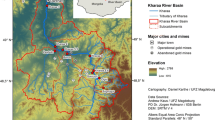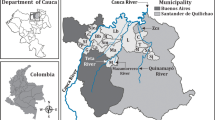Abstract
Purpose of Review
To examine cyanide (CN-) contamination of a large river in southeastern Ecuador that has been severely impacted by the indiscriminate discharge of untreated gold processing effluents.
Recent Findings
Poor environmental stewardship of cyanide (CN-) use by 87 gold processing centers in Portovelo-Zaruma in southern Ecuador to leach residual gold from Hg-contaminated tailings has resulted in high CN- contamination of the Puyango-Tumbes River downstream from the centers.
Summary
Free CN- concentrations were high in river surface waters for 50 km below the processing plants, with the highest concentration 9088 times above the CCME standard of 5 μg/L and 1136 times above the 24-h LC50 concentration of 40 μg/L free CN- for some fish species. Due to cyanidation of mercury-contaminated tailings, the formation of Hg-CN complexes is a grave concern, as these complexes have been shown to be highly bioavailable. Preliminary tests conducted in a laboratory using bioassays with Danio rerio sp. and varying concentrations of synthetic Hg(CN)2 salt have shown significant THg bioaccumulation in muscle and kidney fish tissues exposed to concentrations >0.12 mg/L. Furthermore, low MeHg results in fish tissues demonstrated little occurrence of methylation and that the bulk of the total mercury content was in the form of inorganic mercury. Although construction of a communal tailings facility (CTF) in Portovelo is a positive development to reduce riverine pollution, the requirement to truck tailings up to the CTF likely results in inadequate compliance of environmental regulations that are poorly enforced.


Similar content being viewed by others
References
Papers of particular interest, published recently, have been highlighted as: • Of importance •• Of major importance
Seccatore J, Veiga MM, Origliasso C, Marin T, Tomi GD. An estimation of the artisanal small-scale production of gold in the world. Sci Total Environ. 2014;496:662–7. https://doi.org/10.1016/j.scitotenv.2014.05.003.
Veiga MM, Marshall BG. Colombian artisanal mining sector: formalization is a heavy burden. Ext Ind Soc. 2019;6:223–8.
Veiga MM, Angeloci-Santos G, Meech JA. Review of barriers to reduce mercury use in artisanal gold mining. Ext Ind Soc. 2014b;1(2):351–61.
Spiegel S, Keane S, Metcalf S, Veiga MM. The Minamata convention on mercury and its implications for artisanal gold mining: are policymakers prepared for grassroots implementation? Environ Health Perspect. 2014;12(8):203–4.
•• Gonçalves A d O, Marshall BG, Kaplan RJ, Moreno-Chavez J, Veiga MM. Evidence of decreased mercury loss and increased use of cyanidation at processing centers in southern Ecuador. J Clean Prod. 2017;165:836–45. https://doi.org/10.1016/j.jclepro.2017.07.097. This paper is important as cites cyanide use and tailings management at gold processing plants in Portovelo-Zaruma.
ILO. International Labour Organization. Trends in informal employment in Ecuador: 2009–2012. Programme for the Promotion of Formalization in Latin America and the Caribbean (FORLAC); 2014.
Irvine A. Artisanal and small-scale mining in Ecuador—building and implementing an effective legal framework. Accessed at www.andrewirvinelaw.com. Jan. 2, 2019.
Thomas MJ, Veiga MM, Marshall BG, Dunbar WS. Artisanal gold supply chain: measures from the Ecuadorian government. Res Policy. 2019;64:1–8.
INEC. Instituto Nacional de Estadística y Censos. Resultados del Censo 2010 de población y vivienda en el Ecuador. Fascículo Provincial el Oro; 2010.
Velázquez-López PC, Veiga MM, Hall K. Mercury balance in amalgamation in artisanal and small-scale mining: findings ways to reduce environmental pollution in Portovelo-Zaruma, Ecuador. J Clean Prod. 2010;18(3):226–32.
Veiga MM, Nunes D, Klein B, Shandro J, Velásquez-Lopez PC, Souza RN. Replacing mercury use in artisanal gold mining: preliminary tests of mill-leaching. J Clean Prod. 2009;17:1373–81.
Veiga MM, Angeloci G, Hitch M, Velásquez-López PC. Processing centers in artisanal gold mining. J Clean Prod. 2014a;64:535–44.
Garcia O, Veiga MM, Cordy P, Suescún OE, Molina JM, Roeser M. Artisanal gold mining in Antioquia, Colombia: a successful case of mercury reduction. J Clean Prod. 2015;90:244–52. https://doi.org/10.1016/j.jclepro.2014.11.032.
Drace K, Kiefer AM, Veiga MM. Cyanidation of mercury-contaminated tailings: potential health effects and environmental justice. Curr Environ Health Rep. 2016;3(4):443–9. https://doi.org/10.1007/s40572-016-0113-0.
CIRDI. Canadian International Resources and Development Institute. Environmental assessment and management for artisanal and small-scale mining. October, 2017:1–7.
Nichols B, Veiga M, Van Zyl D, Xavier AM. Closure of artisanal small scale gold mine processing plants in Ecuador. J Manag Sustain. 2015;5(2):41–7. https://doi.org/10.5539/jms.v5n2p4.
Dzombak DA, Ghosh RS, Wong-Chong GM. Cyanide in water and soil: chemistry, risk and management. CRC Press: Taylor and Press Group; 2005.
Donato D, Noller B, Moore M, Possingham H, Ricci P, Bell C, Nicholls O. Cyanide use, wildlife protection and the international cyanide management code: an industry brokered approach. In: Inaugural Global Sustainable Development Conference, Melbourne, Minerals Council of Australia; 2007.
US EPA. Environmental Protection Agency. Ambient Water Quality Criteria for Cyanide. EPA 440/5–84-028; 1985.
CCME. Canadian Council of Ministers of the environment. Canadian Water Quality Guidelines for the Protection of Aquatic Life. Winnepeg, Canada; 2003.
WHO. World Health Organization. Guidelines for drinking-water quality, 2nd ed. Vol. 2. Health criteria and other supporting information. Geneva; 2008.
WHO. World Health Organization. Cyanide in drinking-water. Background document for preparation of WHO Guidelines for drinking-water quality. Geneva; 2009.
WHO. World Health Organization. Guidelines for drinking-water quality, 4th ed, 2011.
Velásquez-López PC, Veiga MM, Klein B, Shandro JA, Hall K. Cyanidation of mercury-rich tailings in artisanal and small-scale gold mining: identifying strategies to manage environmental risks in Southern Ecuador. J Clean Prod. 2011;19:1125–33.
Aliprandini P, Veiga MM, Marshall BG, Scarazzato T, Espinosa DCR. Investigation of mercury cyanide adsorption from synthetic wastewater aqueous solution on granular activated carbon. J Water Process Eng. 2020;34:1–6.
Adams MD. The mechanisms of adsorption of Hg(CN)2 and HgCl2 on to activated carbon. Hydrometallurgy. 1991;26:201–10. https://doi.org/10.1016/0304-386X(91)90031-G.
Flynn, CM, McGill Haslem, S. Cyanide Chemistry – Precious Metals Processing and Waste Treatment. Information Circular 9429, United States Department of the Interior, United States Bureau of Mines. 1995. 282 p.
Aylett BJ. Mercury (II) Pseudohalides: Cyanide, Thiocyanate, Selenocyanate, Azide, Fulminate. Comprehensive Inorganic Chemistry 3:304–306. In: Bailar JC, Harry Julius Emeléus, Sir Ronald Nyholm, Trotman-Dickenson AF, editors. Oxford: Pergamon Press; distributed by Compendium Publishers (Elmsford, NY), 1973, p. 304.
•• Marshall BG, Veiga MM, Kaplan RJ, Adler Miserendino R, Schudel G, Bergquist BA, et al. Evidence of transboundary mercury and other pollutants in the Puyango-Tumbes River basin, Ecuador-Peru. Environ Sci-Proc Imp. 2018;20:632–41. https://doi.org/10.1039/c7em00504k. This publication is important as it outlines the mercury concentrations found in sediments in the Puyango-Tumbes River watershed, including evidence from mercury isotopes that Hg contamination found 160 km downstream in the Tumbes Delta was caused by tailings discharge from gold processing centers in Portovelo-Zaruma.
US EPA. United States Environmental Protection Agency. EPA Method OIA-1677, DW available cyanide by flow injection, ligand exchange and amperometry. EPA Method 6010C; 2007a.
Bastos WR, Malm O, Pfeiffer WC, Cleary D. Establishment and analytical quality control of laboratories for hg determination in biological and geological samples in the Amazon, Brazil. Tech Rev Ciênc Cult. 1998;50:255–60.
Australian Government. Cyanide Management. Leading Practice Sustainable Development Program for the Mining Industry. Commonwealth Copyright Administration, Attorney General’s Department, Robert Garran Offices, National Circuit, Canberra, Australia; 2008.
• Guimarães JRD, Betancourt O, Miranda MR, Barriga R, Cueva E, Betancourt S. Long-range effect of cyanide on mercury methylation in a gold mining area in southern Ecuador. Sci Total Environ. 2011;409:5026–33. https://doi.org/10.1016/j.scitotenv.2011.08.021. This study highlighted the detectability of cyanide concentrations downstream from gold processing plants in Portovelo-Zaruma.
• Tarras-Wahlberg NH, Flachier A, Lane S, Sangfors O. Environmental impacts and metal exposure of aquatic ecosystems in rivers contaminated by small scale gold mining: The Puyango river basin, southern Ecuador. Sci Total Environ. 2001;278(1):239–61. This was the first major study that outlined the concerning pollution of the Puyango-Tumbes River caused by AGM activities.
SGAB-Prodeminca. Plan maestro ambiental para el distrito minero Portovelo-Zaruma y la cuenca del rio Puyango. Quito: Prodeminca, Ministerio de Energia y Minas; 2000.
Appleton JD, Williams TM, Orbea H, Carrasco M. Fluvial contamination associated with artisanal gold mining in the Ponce Enriquez, Portovelo-Zaruma and Nambija areas, Ecuador. Water Air Soil Pollut. 2001;131(1):19–39. https://doi.org/10.1023/A:1011965430757.
Betancourt O, Narváez A, Roulet M. Small-scale gold mining in the Puyango River basin, southern Ecuador: a study of environmental impacts and human exposures. Ecohealth. 2005;2(4):323–32. https://doi.org/10.1007/s10393-005-8462-4.
UNIDO (United Nations International Development Organization). Final Report: Implementing Integrated Measures for Minimizing Mercury Releases from Artisanal Gold Mining in Ecuador. Project No./SAP ID 100271. Sponsored by GEF. Executed by Dept of Mining Engineering, University of British Columbia, Vancouver, Canada, Nov. 2016, v.2, 374 p. (report unavailable).
MacDonald DD, Ingersoll CG, Berger TA. Development and evaluation of consensus-based sediment quality guidelines for freshwater ecosystems. Arch Environ Contam Toxicol. 2000;39(1):20–31. https://doi.org/10.1007/s002440010075.
Núñez Juárez S, Zegarra Loo J. Estudio Geoambiental de la Cuenca del Río Puyango-Tumbes. 2006, 223 p. INGEMMET Boletin No 32, Serie C. Lima, Peru.
Puño N. Environmental management of the Puyango-Tumbes River basin in Ecuador and Peru. In: Clark RM, Hakim S, editors. Securing Water and Wastewater Systems; 2014. p. 161–87. https://doi.org/10.1007/978-3-319-01092-2.
JECFA FAO/WHO. Joint expert committee on food additives – food and agriculture Organization of the United Nations/World Health Organization. Evaluations of the Joint FAO/WHO Expert Committee on Food Additives - methylmercury 2010:1:1–2.
Hinton JJ, Veiga MM, Veiga ATC. Clean artisanal gold mining: a utopian approach? J Clean Prod. 2003;11:99–115. https://doi.org/10.1016/S0959-6526(02)00031-8.
Spiegel SJ, Veiga MM. International guidelines on mercury management in small-scale gold mining. J Clean Prod. 2010;18(4):375–85. https://doi.org/10.1016/j.jclepro.2009.10.020.
Intergovernmental Forum on Mining, Minerals, Metals and Sustainable Development (IGF). Global trends in artisanal and small-scale Mining (ASM): a review of key numbers and issues. Winnipeg: IISD; 2017.
Gonzalez D. Treaty does not stop illicit mercury trade in South America. Minamata Convention aims to reduce global mercury pollution, but may have shifted hazards toward South America’s artisanal mines. Yale Global Online. 2018.
Acknowledgments
The authors would like to acknowledge the support of the United Nations Industrial Development Organization (UNIDO) for this research (Contract No. 3000018026, Project No./SAP ID 100271). In addition, many thanks to China Gold International Resources Corp. Ltd. for their financial support of part of this research. We would also like to thank INIGEMM in Ecuador for conducting the analyses of the water samples. Finally, thanks to Mr. Danilo Castilho from the Association of Owners of the Processing Plants (APROPLASMIN) for support in the field and Robert Kaplan for his part in the field collections.
Author information
Authors and Affiliations
Corresponding author
Ethics declarations
Conflict of Interest
The authors declare no conflicts of interest in the production of this work.
Human and Animal Rights and Informed Consent
This article does not contain any studies with human or animal subjects performed by any of the authors.
Human and Animal Rights
All reported studies/experiments with human or animal subjects performed by the authors have complied with all applicable ethical standards (including the Helsinki declaration and its amendments, institutional/national research committee standards, and international/national/institutional guidelines).
Additional information
Publisher’s Note
Springer Nature remains neutral with regard to jurisdictional claims in published maps and institutional affiliations.
This article is part of the Topical Collection on Water and Health
Rights and permissions
About this article
Cite this article
Marshall, B.G., Veiga, M.M., da Silva, H.A.M. et al. Cyanide Contamination of the Puyango-Tumbes River Caused by Artisanal Gold Mining in Portovelo-Zaruma, Ecuador. Curr Envir Health Rpt 7, 303–310 (2020). https://doi.org/10.1007/s40572-020-00276-3
Published:
Issue Date:
DOI: https://doi.org/10.1007/s40572-020-00276-3




